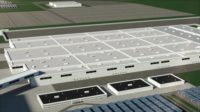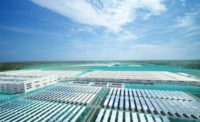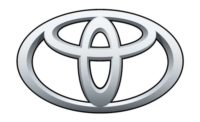Amid the cotton fields and woods of rural Haywood County, Tenn., a 3,600-acre megaproject is taking shape that aims to fast-forward the nation’s market for electric-powered vehicles as well as the way they are built. Ford Motor Co.’s BlueOval City, soon to be home to its largest and most advanced production complex, is its first greenfield assembly plant in more than half a century.
Located 50 miles northeast of Memphis and named for Ford’s iconic logo, BlueOval City’s 5-million-sq-ft onsite assembly facility, theTennessee Electric Vehicle Center (TEVC), will manufacture an expanded lineup of the company’s electric F-series vehicles, powered by batteries produced by development partner SK Innovation of South Korea at a 4.2-million-sq-ft onsite BlueOval SK (BOSK) facility. With expansive property for supplier plants and support operations, BlueOval City will be “a vertically integrated ecosystem,” according to Ford, which declined to speak to ENR for this article.

Ford will manufacture its next-generation electric truck at BlueOval City, which is scheduled for a mid-2024 completion.
Photo courtesy Walbridge Technologies
Everything about BlueOval City is big—from Ford’s $5.6-billion investment to develop the nearly six-square-mile site, to its goals of annually producing approximately 500,000 vehicles and providing 6,000 jobs at full capacity.
Ford has also set ambitious carbon-neutral goals for BlueOval City. According to information from the company, an onsite wastewater treatment plant combined with a water reuse and recycling system will eliminate the assembly plant’s need to tap freshwater sources. Once production is underway, Ford will implement “zero-waste-to-landfill” processes to capture materials and production scrap at an onsite collection center. Materials will be sorted and routed for recycling or processing, either at the plant or at offsite facilities.
Just as sizable are the challenges that have been tackled by the Walbridge-led design-build team responsible for constructing more than 9 million sq ft of high-tech facilities for vehicle and battery manufacturing on an accelerated timeline that calls for having vehicle production underway in early 2025—barely three years after site preparation began.

Crews moved nearly 13 million cu yd of earth to create the 3,600-acre site, shown here as work began on placing foundation concrete.
Photo courtesy Walbridge Technologies
Chris Morgan, vice president for Walbridge’s mobility unit, says a decades-long history with Ford on a variety of projects was a distinct advantage in planning and carrying out such a large, one-of-a-kind effort.
“The work, we know,” Morgan says. “It’s just at a massive scale—the biggest megaproject we’ve done in our history.”
Applying design-build project delivery with equally experienced design and engineering partners proved advantageous as well, creating the collaboration needed to meet Ford’s milestones, drive design decisions and adjust plans as needed—a frequent occurrence given rapidly evolving electric vehicle and battery technologies.
“Our roles and responsibilities are well understood because we’ve worked with both Walbridge and Ford a great deal,” explains Todd Rogus, senior project manager for Ghafari, engineer-of-record for the BOSK battery plant. “That helped us move quickly through design.”
“The work, we know. It’s just at a massive scale—the biggest megaproject we’ve done in our history.”
—Chris Morgan, Vice President, Walbridge
Morgan notes that design-build also facilitated input from the project’s major subcontractors.
“If we get stuck, have an issue or need a creative idea, we have everyone involved looking at the best way to figure it out,” he says.
Perhaps the most essential element for making BlueOval City a reality was craft labor, and the project required a huge supply of it. In the year leading up to the start of site preparation in early 2022, Walbridge laid out a craft curve Morgan likens to “a tidal wave,” identifying the timing for both skills and personnel that would peak with approximately 4,000 workers on site.
Walbridge utilized every avenue to identify and recruit a workforce capable of meeting BlueOval City’s demanding quality and time requirements. Efforts included local outreach via trade fairs and contacts with the nearby Tennessee College of Applied Technology as well as engagement with unions on a national level, backed by Ford’s commitment to implement a project labor agreement. Many local trades proactively implemented apprentice programs as a safeguard against staffing gaps.
In assembling subcontractors, Morgan adds, “we had to strategically break down the scopes of work because it was just too big for any one firm. As we bid them out, we verified their capacity to manage the work at a fair price.”

With its relatively remote location, the project has relied extensively on offsite prefabrication.
Photo courtesy Ford
Getting Rolling
Getting the existing 3,600-acre parcel of BlueOval City “pad-ready” for the two production facilities required a massive earthmoving effort totaling just under 13 million cu yd of soil, 15 miles of silt fencing to safeguard existing streams and wetlands and a robust stormwater management system to make the site as sustainable and resilient as possible.
Walbridge also installed more than 29 miles of underground piping for utilities, custom electrical systems, access roads, a railroad spur and shipping area. Approximately 30,000 tons of structural steel and 600,000 cu yd of concrete were required for the steel-framed facilities, both of which are founded on thousands of 6-ft-dia to 8-ft-dia caissons drilled an average of 70 ft deep to meet the area’s Category D seismic requirements.
“We were able to minimize design and construction clashes, which saved Ford time, trouble and money.”
—Greg Brogley, Senior Vice President, SSOE Group
Morgan calls the 5-million-sq-ft TEVC assembly plant more of a “traditional automotive assembly facility,” albeit for an innovative product. Engineered by SSOE Group, the facility will contain a stamping plant, body shop, assembly line, administration and security offices and related site utility infrastructure. Greg Brogley, SSOE senior vice president for facilities operations, says the design’s use of all-electric mechanical equipment instead of natural gas reduces the generation of greenhouse gases and nitrogen oxide (NOx) pollutants.
“We also incorporated amenities that will provide an attractive working environment for Ford employees,” Brogley adds.
While Morgan says the TEVC alone would have comprised a major project for the team, the BOSK amplified and broadened those technical challenges, given its unique processes and clean room and dry room spaces supported by building systems designed to consistently provide exacting environments.
“Couple that with a tight timeline and technology that the world is trying to accelerate into more mass production, then squish it all into a 4-million-square-foot box,” says Mike Ryan, Ghafari senior vice president. “It’s an interesting adventure.”
To meet these unique requirements, the building’s approximately 3,000-ft-long, 1,000-ft-wide ground-level production footprint is augmented with a mezzanine level housing building system equipment.

The project will use nearly 30 miles of underground piping, 30,000 tons of structural steel and 60,000 cu yd of concrete.
Photo courtesy Ford
Dave Green, Walbridge’s project director, says the team applied a “layered cake” approach to install the building systems in the 30 ft of interstitial space, working downward from the bottom truss chord in stages with piping, conduit, cabling and ductwork.
“Everyone was given a window and a time frame, essentially coming down 10 feet at a time,” Green says. “It proved to be a very efficient system.”
So too was the integration of the large mechanical pipe rack “spine” bisecting the facility. Fabricated in 10-ft to 20-ft sections to match the column spacing, the pipe rack was installed in sequence with the structural steel with no need for an additional crane.
Given BlueOval City’s relatively remote location, the facilities relied extensively on offsite prefabrication, which reduced onsite congestion during the peak of construction activity.
“Our sheet metal contractor opened a shop 30 miles east of here to fabricate the majority of ductwork,” Green notes.
A Constant Balancing Act
The calendar wasn’t BlueOval City’s only competition. With other large projects around the country vying for materials and supply chains still rife with pandemic-related kinks, Green says Walbridge took a “backwards” approach to ordering major components, securing roofing, siding, air handlers and switchgear before buying steel.
With Ford also building the $5.8-billion BlueOval-SK Battery Park in Kentucky, “we had to look at the capacity of both projects’ suppliers and contractors to make sure we weren’t affecting them,” he adds.
Karlos Melgar, Walbridge’s project director for the TEVC, adds that large amounts of aggregate, building materials and equipment were procured early in the project and stored on site to ensure everything was available when it was needed. In keeping with Ford’s sustainability commitment, an onsite batch plant produced 600,000 cu yd of concrete for the two facilities, removing dozens of trucks from local highways.
“Some changes were pretty intense. We were constantly working to bridge the gap between our facilities and process teams.”
—Matt Kraft, Senior Vice President, Ghafari
“We also secured agreements with two equipment rental companies to set up yards with fleets available to satisfy the project needs,” Melgar adds.
Applying a variety of building information modeling and project management tools teamwide helped keep the multiple moving parts of the design and construction activities in sync, helping the team manage massive amounts of design data and tracking movements of materials and trucks, including, at one point, up to 50 deliveries of steel per day.
Matt Kraft, Ghafari senior vice president, adds that the tools helped the design team stay ahead of technology-driven process changes as much as possible. “Some changes would be pretty intense,” he says. “We were constantly working to bridge the gap between our facilities and process teams to ensure a unified approach and keep surprises to a minimum.”
With SSOE having performed all design BIM/CAD coordination for the campus, “we were able to minimize design and construction clashes, which saved Ford time, trouble and money,” adds Brogley.
Underlying all of these tools, says Morgan, was the fundamental element of sharing information. A daily huddle provided a forum to review safety issues, scheduled activities, logistics, workflow changes and key milestones. Having Ford executives on site also helped secure quick approvals when changes were needed.
“It sounds simple, but it’s the little things that make a good job,” Morgan adds.
Weather, the variable no level of planning can control, played havoc with the facilities’ construction schedule, as western Tennessee saw three times its normal annual rainfall during the project’s first year. Temporary stormwater collection areas and pumps helped keep in-process excavation sites viable for continued activity while extended hours and resequenced tasks helped regain lost time.

Both production facilities are more than 80% complete and fully enclosed.
Photo courtesy Ford
Yet while Tennessee was being drenched, a drought in the upper Midwest brought Mississippi River levels to all-time lows. That left many barges unable to reach docks to off-load large-volume materials, requiring a scramble to find alternate overland transport options.
In early March, both production facilities were more than 80% complete and fully enclosed, with the project’s focus shifting to finishes and utilities commissioning as well as process equipment installation by separate contractors.
Brogley praises the teamwide collaboration that helped streamline a highly complex, multifaceted project into an efficient process, which included working with Ford on value engineering approaches that realized $227 million in construction-related savings.
The result, Brogley says, “is a much better end product for the Ford production team.”
Walbridge’s Green admits that at the outset, the scope and scale of BlueOval City seemed rather overwhelming. With the finish line in sight, he adds, “it’s starting to feel normal now.”





Post a comment to this article
Report Abusive Comment